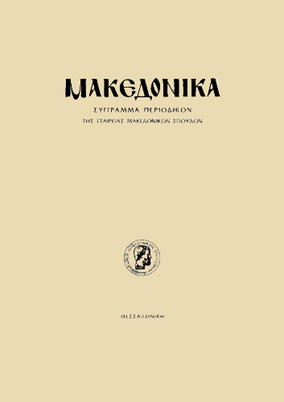Το μονύδριο της Παναγίας και ο Θεολόγος της Θάσου
Part of : Μακεδονικά ; Vol.24, 1984, pages 112-138
Issue:
Pages:
112-138
Parallel Title:
The small monastery of Panaghia at Theologos-Thasos
Section Title:
Articles
Abstract:
Four km south of Theologos at the site Ano and Kato Polîtes after the Fall of Constantinople, according to the tradition, refugees who fled to Thassos founded the two homonymous adjacent settlements. What remains of them today, among rich vegetation, are the ruins of houses and of two churches: Aghios Charalambos in Kato Polites and Aghios Constantinos in Ano Polîtes.The population of Polites moved later to Theologos, founded together with the village Kazaviti later than 1479, when the Turks settled on the island. The original site of Theologos is «pera mahalas» at the eastern side of theAghia Vassiliki Stream, on the other side of which is lying the present village.In «pera mahalas» are to be found the ruins of numerous houses, a square tower probably of the 16th C and the churches Panaghia tis Kartsliotinas and Taxiarchis Archangelos Michael. The settlement was founded at its actual site in the early 18th C, when with the expansion of piracy and the annihilation of commerce, the inhabitants of the rich commercial settlements of the S.E. coast abandoned them and settled down at Theologos, originally in the area surrounding the monastery of Panaghia, where the remains of typical local architecture can be found. The village later expanded to the north in the vicinity of the churches Aghios Demetrios (1808) and Aghia Paraskevi (1871), its style influenced by Macedonian architecture.The small monastery of Panaghia, quite possibly one of the numerous metochia of the Philotheos monastery of Thassos, is composed of: the church of Panaghia, the workshop «ergasiiri», a peculiar two storey building (1,25 m height each storey), the ossuary («osteophylakio»), «Aghios Modestos», a two storey dwelling with an adjacent building on ground level, the oven, the wine press and the enclosure. The votive inscription of the wooden templon dates the eastern part of the church in 1633. The remaining part of the one aisled, wooden roofed basilica with a gynaeceum in its western part, is dated from 1780 together with the workshop and with «Aghios Modestos». Roman ar chitectural marble parts built in its masonry as well as others lying around, show that the region was already inhabited from the Roman era.
Subject (LC):
Notes:
856:https://ejournals.epublishing.ekt.gr/index.php/makedonika/article/view/5824, DOI: https://doi.org/10.12681/makedonika.263
Electronic Resources:




